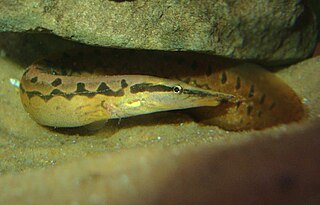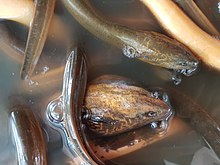
The American white ibis is a species of bird in the ibis family, Threskiornithidae. It is found from Virginia via the Gulf Coast of the United States south through most of the coastal New World tropics. This particular ibis is a medium-sized bird with an overall white plumage, bright red-orange down-curved bill and long legs, and black wing tips that are usually only visible in flight. Males are larger and have longer bills than females. The breeding range runs along the Gulf and Atlantic Coast, and the coasts of Mexico and Central America. Outside the breeding period, the range extends further inland in North America and also includes the Caribbean. It is also found along the northwestern South American coastline in Colombia and Venezuela. Populations in central Venezuela overlap and interbreed with the scarlet ibis. The two have been classified by some authorities as a single species.

Synbranchiformes, often called swamp eels, is an order of ray-finned fishes that are eel-like but have spiny rays, indicating that they belong to the superorder Acanthopterygii.

The swamp eels are a family (Synbranchidae) of freshwater eel-like fishes of the tropics and subtropics. Most species are able to breathe air and typically live in marshes, ponds and damp places, sometimes burying themselves in the mud if the water source dries up. They have various adaptations to suit this lifestyle; they are long and slender, they lack pectoral and pelvic fins, and their dorsal and anal fins are vestigial, making them limbless vertebrates. They lack scales and a swimbladder, and their gills open on the throat in a slit or pore. Oxygen can be absorbed through the lining of the mouth and pharynx, which is rich in blood vessels and acts as a "lung".
Gnathostomiasis, also known as larva migrans profundus, is the human infection caused by the nematode Gnathostoma spinigerum and/or Gnathostoma hispidum, which infects vertebrates.

The walking catfish is a species of freshwater airbreathing catfish native to Southeast Asia. It is named for its ability to "walk" and wiggle across dry land, to find food or suitable environments. While it does not truly walk as most bipeds or quadrupeds do, it can use its pectoral fins to keep it upright as it makes a wiggling motion with snakelike movements to traverse land. This fish normally lives in slow-moving and often stagnant waters in ponds, swamps, streams, and rivers, as well as in flooded rice paddies, or temporary pools that may dry up. When this happens, its "walking" skill allows the fish to move to other aquatic environments. Considerable taxonomic confusion surrounds this species and it has frequently been confused with other close relatives. One main distinction between the walking catfish and the native North American ictalurid catfish with which it sometimes is confused, is that the walking catfish lacks an adipose fin. It can survive 18 hours out of water.

Bubble nests, also called foam nests, are created by some fish and frog species as floating masses of bubbles blown with an oral secretion, saliva bubbles, and occasionally aquatic plants. Fish that build and guard bubble nests are known as aphrophils. Aphrophils include gouramis and the synbranchid eel Monopterus alba in Asia, Microctenopoma (Anabantidae), Polycentropsis (Nandidae), and Hepsetus odoe in Africa, and callichthyines and the electric eel in South America. Most, if not all, fish that construct floating bubble nests live in tropical, oxygen-depleted standing waters. Osphronemidae, containing the Bettas and Gouramies, are the most commonly recognized family of bubble nest makers, though some members of that family mouthbrood instead. The nests are constructed as a place for fertilized eggs to be deposited while incubating and guarded by one or both parents until the fry hatch.
Gnathostoma spinigerum is a parasitic nematode that causes gnathostomiasis in humans, also known as its clinical manifestations are creeping eruption, larva migrans, Yangtze edema, Choko-Fuschu Tua chid and wandering swelling. Gnathostomiasis in animals can be serious, and even fatal. The first described case of gnathostomiasis was in a young tiger that died in the London Zoo in 1835. The larval nematode is acquired by eating raw or undercooked fish and meat.

Hoplosternum littorale is a species of catfish belonging to the Callichthyinae subfamily of the family Callichthyidae. It is known as tamuatá in Brazil, atipa in French Guiana, hassa in Guyana, kwi kwi in Suriname, cascadu or cascadura in Trinidad and Tobago, and busco or currito in Venezuela.

The zig-zag eel, also known as the tire-track eel, tire-track spiny eel or marbled spiny eel, is a species of ray-finned, spiny eels belonging to the genus Mastacembelus of the family Mastacembelidae, and is native to the riverine fauna of India, Bangladesh, Pakistan, Sri Lanka, Thailand, Vietnam, Indonesia and other parts of Southeast Asia. The species was described as Macrognathus armatus by Lacepède in 1800. Other common names for this popular aquarium species are leopard spiny eel and white-spotted spiny eel. This species is not only a popular aquarium fish but also as a food fish in its country of origin.

Monopterus is a genus of swamp eels native to Asia. They live in various freshwater habitats and some have a fossorial lifestyle.

Pomacea canaliculata, commonly known as the golden apple snail or the channeled apple snail, is a species of large freshwater snail with gills and an operculum, an aquatic gastropod mollusc in the family Ampullariidae, the apple snails. South American in origin, this species is considered to be in the top 100 of the "World's Worst Invasive Alien Species". It is also ranked as the 40th worst alien species in Europe and the worst alien species of gastropod in Europe.

The peacock eel or spotfin spiny eel is a spiny eel found in freshwater habitats throughout Southeast Asia. They are commercially important as food and aquarium fish.

The Chinese rice fish is a species of fish in the genus Oryzias. This freshwater fish occurs in swamps, stagnant parts of streams, rice fields and marshes, and is up to 3.1 cm (1.2 in) long. It was formerly considered a subspecies of the Japanese rice fish. The natural range of the Chinese rice fish is in East and Southeast Asia, including the Yangtze, Mekong, Irrawaddy, Salween, Red River and Nanpangjiang basins. It has been introduced to Kazakhstan and Russia ; also spreading in the Azov basin and has been discovered in the Obytichna River in Ukraine.
Ophichthys desilvai is a commercially important, air-breathing species of fish in the family Synbranchidae. It is endemic to Sri Lanka and is the only endemic synbranchid from there.

Ophisternon bengalense the Bengal eel, Bengal mudeel or onegill eel, is a species of fish in the family Synbranchidae. It is endemic to freshwater and brackish water rivers and swamps in Oceania and South Asia. It is normally 100 cm in maximum length.
A rice-fish system is a polyculture practice that integrates rice agriculture with aquaculture, most commonly with freshwater fish. This practice is highly valued as it was one of the first to be considered as a “Globally Important Agricultural Heritage System” according to FAO-GEF. It is based on a mutually beneficial symbiotic relationship between rice and fish that is developed when introduced into the same ecosystem. Many benefits in various spheres come with these systems.

Synbranchinae is a subfamily of swamp eel, consisting of six of the ten genera in the family Synbranchidae. The remaining genus, the monotypic Macrotrema is the only one in the other subfamily Macrotreminae. The subfamily occurs in the Neotropics, Afrotropics and Asia.
Rakthamichthys is a genus of swamp eels that are endemic to India. Three species are known from the Western Ghats and one is known from Northeast India.

Typhlosynbranchus is a genus of swamp eels that are native to West and Central Africa. It contains two species that were formerly classified in the primarily Asian genus Monopterus.


















